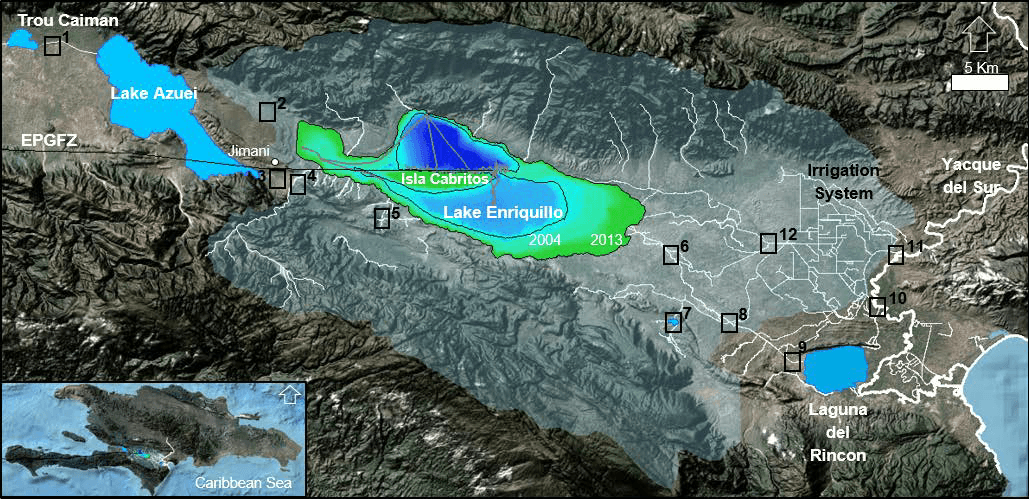Lacustrine Flooding Hazards Research
Quaternary Paleoseismicity Research // Sediment Properties and Velocity Research // Lake Flooding Research
Factors Contributing to the 2005-Present, Rapid Rise in Lake Levels, Dominican Republic and Haiti (Hispaniola)
[Poster ::: Paper]
Lake level elevation at Lake Enriquillo and Lake Azuei, the two largest lakes in Hispaniola and in the Caribbean, respectively rose by 10 m and 5 m between 2004 and 2013 (Figure 1). Higher lake levels submerged towns, road systems, agricultural lands and utilities, and threatened to submerge the major overland highway that connects the Dominican Republic and Haiti. This study used CHIRP seismic data, satellite imagery, and regional meteorological data to quantify and assess controls on lake level rises. The result showed that increases to hurricane activity and basin wide hydraulic connectivity is the likely cause. I, along with my co-authors, propose that the lakes also experience intermittent periods of hydraulic connectivity along reactivated or newly developed stratigraphic-controlled sub-surface transport pathways. We also note that moderately small earthquakes along the large active fault system that extends through both lakes may promote or limit hydraulic conductivity on decadal or shorter time scales. The extents to which recent earthquakes have triggered changes in groundwater flow at this site remain unclear but represent an important topic of future research.
 Figure 1. A map that focuses on Lake Enriquillo’s drainage basin and the hydrologic connection between the water bodies within and outside of the basin. Water body locations that have undergone hydrologic changes since 2003 are boxed and numbered; white lines indicate streams or man-made channels; gray lines within the lakes are the seismic track lines. The map also shows the pattern of the lake’s areal growth since 2004 and the location of the Enriquillo-Plantain Garden Fault zone (EPGFZ). Since 2004 the lake has grown significantly more easterly or westerly than northerly or southerly.
Figure 1. A map that focuses on Lake Enriquillo’s drainage basin and the hydrologic connection between the water bodies within and outside of the basin. Water body locations that have undergone hydrologic changes since 2003 are boxed and numbered; white lines indicate streams or man-made channels; gray lines within the lakes are the seismic track lines. The map also shows the pattern of the lake’s areal growth since 2004 and the location of the Enriquillo-Plantain Garden Fault zone (EPGFZ). Since 2004 the lake has grown significantly more easterly or westerly than northerly or southerly.